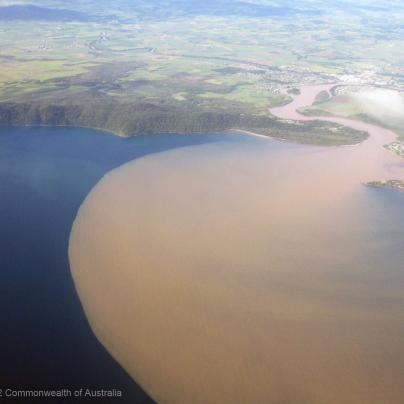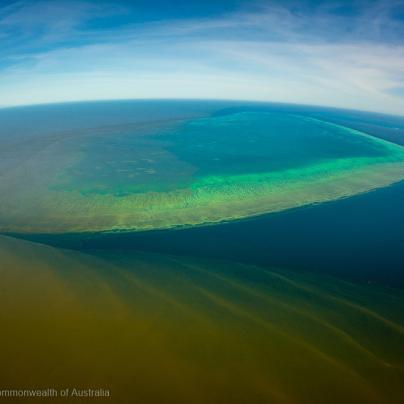Land-based run-off remains the greatest contributor to poor water quality in the inshore areas of the Great Barrier Reef and is a major contributor to the current poor state of many inshore marine ecosystems.
Since European settlement, Reef water quality has declined due to coastal development and agricultural activities in adjacent catchments.
- The main water quality pollutants in land-based run-off that pose a threat to the Reef are primarily from agricultural activities in the catchments and include:
- Fine sediment
- Excess nutrients
- Pesticides (herbicides, insecticides and fungicides) and other pollutants.
Position statement
On 17 February 2021, the Authority released a position statement on water quality in the Great Barrier Reef:
The position statement outlines key pollutants contributing to the decline of water quality on the Reef and their impacts on Reef ecosystems.
There are 35 major catchments draining into the Great Barrier Reef Region, many of which have been highly modified for agricultural activities. Grazing lands are the main contributor of fine sediment and particulate nitrogen on the Reef. Sugarcane crops are the primary source of excess nutrients (dissolved) and pesticides.
- Other agricultural industries (e.g. horticulture), urban areas, sewage treatment plants, aquaculture activities, mining, industrial areas, ports, and defence activities also contribute to pollutants across the Region. This can include:
- coal dust
- petroleum hydrocarbons
- heavy metals
- marine debris and microplastics
- pharmaceuticals and personal care products.
The Reef Authority acknowledges efforts to improve land management practices by landholders and the community in partnership with governments, natural resource managers, industry, research and conservation groups.
There has been some progress towards achieving water quality targets in the Reef 2050 Water Quality Improvement Plan. However, an urgent need remains to implement innovative and targeted actions to further improve the quality of water entering the Reef from all land-based sources.
Picture 1 - Johnstone River flood plume
Picture 2 - Algae growing on bleached coral
Picture 3 - Flood plume from Townsville flood event



Pollutants in land-based run-off reduce Reef resilience and affect biodiversity . Inshore areas of the Marine Park experience the highest impacts, whereas mid-shelf and outer-reefs are rarely influenced by run-off due to their distance from river mouths and the primary northward flow of most Queensland rivers.
However, flood plumes can reach these distant areas after large rainfall events (such as the 2019 Townsville floods).
- Increased concentrations of sediment, nutrients and pesticides can have significant impacts on the Reefs plants, animals, and ecosystem functions. Some well-documented impacts are:
- High concentrations of fine sediment can reduce coral diversity, affect reproduction, disrupt coral recruitment and increase susceptibility to disease. It can also damage gills and affect the metabolism of some fish species.
- Suspended sediment, together with nutrients and other organic particles, reduces the amount of available light for seagrass and corals to grow.
- High concentrations of nutrients are an additional stress factor for many coral species and can exacerbate outbreaks of crown-of-thorns starfish. Nutrients can also promote excess growth of algae, which competes with coral for space, and epiphytic algae reduces the capacity of seagrass to photosynthesise.
Pesticides used on crops to protect against pests can harm coastal habitats and some freshwater and estuarine and nearshore marine habitats.
Ecosystem declines due to poor water quality can lead to a decline in Reef-dependent industries, such as tourism and fishing. Poor water quality can also negatively affect people’s well-being and enjoyment of the Reef through degraded aesthetics. Declining water quality and changes to Reef ecosystems may affect Traditional Owners and their connection to sea country.
Resilient reefs can regenerate after a disturbance if given sufficient time to recover and can continue to support a high variety of species, even if they do not return to their original condition.
More frequent and intense storms and rainfall events are predicted for the future which will allow less time for coral reefs to recover and adapt, and reduce their ability to withstand other impacts from climate change, coastal development and direct use of the Marine Park.
The Authority is committed to actions that support Reef resilience and work in partnership with key stakeholders to improve water quality and protect the Great Barrier Reef.
The Authority developed water quality guidelines to support a healthy Reef ecosystem. They set limits for levels of sediments, nutrients and pesticides in the Marine Park which prompt management action if exceeded. Regional catchment-level objectives are being implemented under Queensland’s Environmental Protection (Water and Wetland Biodiversity) Policy 2019.
To better understand the condition, trend and effect of water quality in the Marine Park, the Authority established the Great Barrier Reef Marine Monitoring Program in 2005. It is undertaken by collaborating organisations and is managed by the Authority. The program contributes to understanding the effect of pressures on inshore reefs and seagrass meadows and informs stakeholders about Reef health.
The Authority is a partner in the Australian and Queensland Governments' joint commitment to a Reef 2050 Water Quality Improvement Plan, which seeks to improve the quality of water flowing from the catchments adjacent to the Great Barrier Reef.
- The Reef Authority supports:
- Actions to improve land management practices to better meet water quality targets
- Ongoing, targeted investment and monitoring that considers social, cultural and economic outcomes
- The protection and restoration of key coastal ecosystems critical to Reef health
- Strengthened partnerships and collaboration to reduce cumulative impacts on the Reef
- Education and stewardship activities that ensure adequate stakeholder communication and engagement for improved water quality outcomes.
Land-based facilities discharging sewage effluent directly into the Marine Park are managed under the Sewage Discharge Policy 2005 and the Great Barrier Reef Marine Park Regulations 1983.
Aquaculture facilities located within and next to the Marine Park are regulated through Queensland law under the Great Barrier Reef Marine Park (Aquaculture) Regulations 2000 to ensure local waterways and the Great Barrier Reef are protected from pollutants in discharge.
These facilities must adhere to the Authority’s Guidelines for Aquaculture within the Great Barrier Reef Marine Park.
Marine ecosystems require good quality water to remain healthy. The Great Barrier Reef Marine Park Authority has Water Quality Guidelines for the Great Barrier Reef Marine Park (2010) with set levels for specific pollutants which when exceeded prompt managers to take action.
The guidelines focus on levels of sediments, nutrients and pesticides — the main catchment run-off pollutants that affect water quality on the Great Barrier Reef. Regional catchment-level objectives are being implemented under Queensland’s Environmental Protection (Water and Wetland Biodiversity) Policy 2019 for the Reef catchment.
In some locations current water quality condition is as good as or better than the guideline levels — however the objective of the guidelines remains the same. In areas where water quality is not as high, further improvement to current conditions is the target objective. These objectives are derived to support high ecological value ecosystems.
Information for specific basins and their adjacent marine waters can be found at the Environmental Protection Policy (Water and Wetland Biodiversity) webpage. There are basin level water quality objectives in:
- Wet Tropics region including all waters of the Daintree, Mossman, Barron, Mulgrave-Russell and Trinity Inlet, Johnstone, Tully, Murray, Hinchinbrook Island and Herbert River basins.
- Townsville region including all waters of the Black and Ross River basins, Cleveland Bay, Magnetic Island.
- Mackay-Whitsundays region including all waters of the O'Connell, Pioneer and Proserpine River basins, Plane Creek and Whitsunday Island basins, Repulse Bay, the Whitsundays.
- Capricorn and Curtis Coast region including all waters of the Styx, Shoalwater and Water Park Creek Basins, Keppel Bay, the Boyne, Calliope and Curtis Island Basins, including Gladstone Harbour, the Narrows, lower Fitzroy estuary.
- Other basins include Cape York, Wet Tropics (coastal waters), Burdekin-Don-Haughton, Mackay-Whitsunday (coastal waters) and the Fitzroy region.
For waters of the Great Barrier Reef that are outside state coastal waters, the objectives from adjacent waters of the same type apply. For instance, mid-shelf water quality objectives for Michaelmas Cay would apply to the mid-shelf waters of Opal Reef.
Each of the regional schedule documents has a description of the data that have been analysed and outlines the decision process supporting the guidelines. The general approach is to use locally applicable data as a basis for deriving guidelines. The data for open coastal waters and further seaward waters are generally sourced from Australian Institute of Marine Science monitoring programs.
Guidelines values are derived from site data that falls within particular water bodies. These values were compared against the current water quality guidelines. Where local water quality data meet or exceed the guideline values, values were set to maintain this condition. Where data did not meet these guideline values, the 2010 guideline value was adopted (i.e. annual and seasonal means).
Benthic light guidelines that support seagrass growth have been implemented through these schedules. These are sourced from James Cook University and predecessor agencies. Light levels are specified as photosynthetic active radiation moving averages depending on seagrass species.
Updated guideline levels for a number of pesticides have been determined in the intervening years since initial publication, and more are proposed. These levels are undergoing a national guidelines review process. When that process is complete the intention is that they would supersede those published in the current guidelines. Updates can be found at the Australian and New Zealand Guidelines for Fresh and Marine Water Quality 2018 webpage.
In recognition of the outstanding universal value of this World Heritage Area pollutant concentrations derived to be protective of 99 per cent of species are applied routinely as trigger values for catchment run-off toxicants.
Actions and progress to improve marine water quality is tracked and reported primarily through the Marine Monitoring Program’s annual technical reports for inshore water quality and the review process for pesticides is underway.
